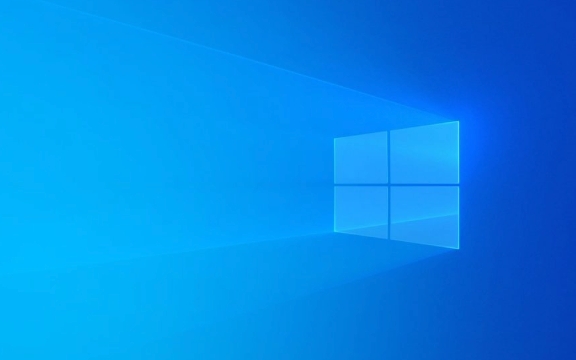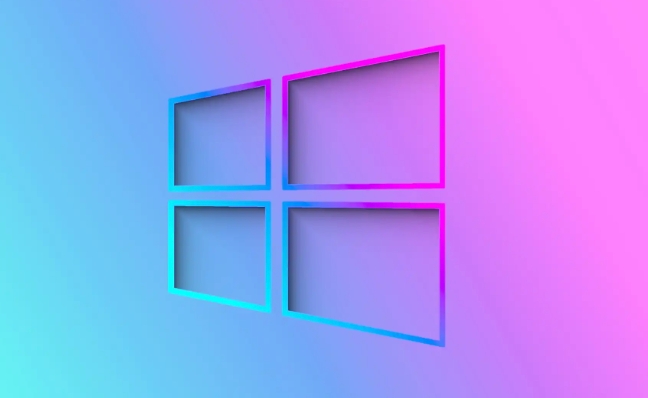First make sure that the network is set to a "dedicated" network, then enable network discovery and file sharing, and confirm that necessary services such as Function Discovery, SSDP, UPnP are running; check that the computer name is consistent with the workgroup (default WORKGROUP); if the problem persists, try to reset the network; if it cannot be displayed, you can directly access it through \computer name or \IP; finally check whether the firewall or antivirus software blocks sharing. As long as the sharing can be accessed through name or IP, the function is normal. It is not displayed on the network. It is only a convenience problem. The problem can usually be solved after the above steps are completed.

If your Windows 10 computer name isn't showing up on the network, it can make file sharing, remote access, or printer sharing difficulty. This issue is common in home or small office networks and usually stems from network discovery settings, services, or name resolution problems. Here's how to troubleshoot and fix it.

? 1. Enable Network Discovery and File Sharing
Windows 10 may have network discovery turned off by default, which hides your computer from others.
Steps:

- Press
Win Ito open Settings . - Go to Network & Internet > Ethernet (or Wi-Fi , depending on connection).
- Click on the active network connection.
- Under Network profile , make sure it's set to Private (not Public).
- Public profile disables discovery for security.
Now enable discovery:
- Open Control Panel > Network and Sharing Center > Change advanced sharing settings .
- Under Private network profile:
- Turn on Network discovery
- Turn on File and printer sharing
- Click Save changes .
? You may need to restart your computer for these changes to take full effect.

? 2. Ensure Necessary Services Are Running
Several background services are required for your computer to appear on the network.
Check these services:
- Press
Win R, typeservices.msc, and press Enter. - Verify the following services are Running and set to Automatic :
- Function Discovery Resource Publication
- SSDP Discovery
- UPnP Device Host
- Computer Browser (if present)
- DNS Client
- Function Discovery Provider Host
?? If any are stopped, right-click → Start . Then double-click to set Startup type to Automatic .
? 3. Verify Computer Name and Workgroup
Even if discovery is on, incorrect naming or workgroup settings can prevent visibility.
Check your computer name:
- Right-click This PC > Properties .
- Confirm the Computer name is set and make sense (eg,
MYPC). - Ensure all computers are in the same Workgroup (usually
WORKGROUPby default).- Change if needed via Change settings under "Computer name, domain, and workgroup settings".
? After changing name/workgroup, a restart is required.
? 4. Use Network Reset (if other fixes fail)
Sometimes network configurations get corrupted.
Try a network reset:
- Go to Settings > Network & Internet > Status .
- Scroll down and click Network reset .
- Click Reset now → confirm.
? This will remove and reinstall all network adapters and reset settings to default. You'll need to reconnect to Wi-Fi afterward.
? 5. Access by IP or Full Computer Name (Workaround)
Even if the computer doesn't appear in Network in File Explorer, you can still access it directly.
Try this in File Explorer address bar:
\\ComputerName
or
\\192.168.1.100 ← (replace with the actual IP of the target computer)
To find the IP:
- On the target PC, open Command Prompt and type:
ipconfig
- Look for IPv4 Address under your active connection.
- Temporarily disable antivirus/firewall to test.
- Ensure Windows Defender Firewall allows File and Printer Sharing :
- Go to Control Panel > Windows Defender Firewall > Allow an app through firewall .
- Make sure File and Printer Sharing is checked for Private (and maybe Public, if needed).
- [ ] Network set to Private
- [ ] Network discovery and File sharing enabled
- [ ] Required services running
- [ ] Correct computer name and workgroup
- [ ] Firewall not blocking discovery
- [ ] Tried accessing via
\\ComputerNameor\\IP
? Tip: Assign a static IP to avoid changes after reboot.
? 6. Firewall or Antivirus Blocking Discovery
Third-party firewalls or security suites may block network discovery traffic.
Summary Checklist
It's not always necessary for a PC to show up in the "Network" section — as long as you can access shared folders using the computer name or IP, functionality is intact. The visibility in File Explorer is more of a convenience feature and can be finished.
Basically, fix the settings above, and most of the time, it'll start appearing — or at least be accessible.
The above is the detailed content of win 10 computer name not showing up on network. For more information, please follow other related articles on the PHP Chinese website!

Hot AI Tools

Undress AI Tool
Undress images for free

Undresser.AI Undress
AI-powered app for creating realistic nude photos

AI Clothes Remover
Online AI tool for removing clothes from photos.

Clothoff.io
AI clothes remover

Video Face Swap
Swap faces in any video effortlessly with our completely free AI face swap tool!

Hot Article

Hot Tools

Notepad++7.3.1
Easy-to-use and free code editor

SublimeText3 Chinese version
Chinese version, very easy to use

Zend Studio 13.0.1
Powerful PHP integrated development environment

Dreamweaver CS6
Visual web development tools

SublimeText3 Mac version
God-level code editing software (SublimeText3)

Hot Topics
 Windows Security is blank or not showing options
Jul 07, 2025 am 02:40 AM
Windows Security is blank or not showing options
Jul 07, 2025 am 02:40 AM
When the Windows Security Center is blank or the function is missing, you can follow the following steps to check: 1. Confirm whether the system version supports full functions, some functions of the Home Edition are limited, and the Professional Edition and above are more complete; 2. Restart the SecurityHealthService service to ensure that its startup type is set to automatic; 3. Check and uninstall third-party security software that may conflict; 4. Run the sfc/scannow and DISM commands to repair system files; 5. Try to reset or reinstall the Windows Security Center application, and contact Microsoft support if necessary.
 PEAK Voice Chat Not Working on PC: Check This Stepwise Guide!
Jul 03, 2025 pm 06:02 PM
PEAK Voice Chat Not Working on PC: Check This Stepwise Guide!
Jul 03, 2025 pm 06:02 PM
Players have been experiencing the PEAK voice chat not working issue on PC, impacting their cooperation during climbs. If you are in the same situation, you can read this post from MiniTool to learn how to resolve PEAK voice chat issues.Quick Navigat
 Windows stuck on 'undoing changes made to your computer'
Jul 05, 2025 am 02:51 AM
Windows stuck on 'undoing changes made to your computer'
Jul 05, 2025 am 02:51 AM
The computer is stuck in the "Undo Changes made to the computer" interface, which is a common problem after the Windows update fails. It is usually caused by the stuck rollback process and cannot enter the system normally. 1. First of all, you should wait patiently for a long enough time, especially after restarting, it may take more than 30 minutes to complete the rollback, and observe the hard disk light to determine whether it is still running. 2. If there is no progress for a long time, you can force shut down and enter the recovery environment (WinRE) multiple times, and try to start repair or system restore. 3. After entering safe mode, you can uninstall the most recent update records through the control panel. 4. Use the command prompt to execute the bootrec command in the recovery environment to repair the boot file, or run sfc/scannow to check the system file. 5. The last method is to use the "Reset this computer" function
 Proven Ways for Microsoft Teams Error 657rx in Windows 11/10
Jul 07, 2025 pm 12:25 PM
Proven Ways for Microsoft Teams Error 657rx in Windows 11/10
Jul 07, 2025 pm 12:25 PM
Encountering something went wrong 657rx can be frustrating when you log in to Microsoft Teams or Outlook. In this article on MiniTool, we will explore how to fix the Outlook/Microsoft Teams error 657rx so you can get your workflow back on track.Quick
 The requested operation requires elevation Windows
Jul 04, 2025 am 02:58 AM
The requested operation requires elevation Windows
Jul 04, 2025 am 02:58 AM
When you encounter the prompt "This operation requires escalation of permissions", it means that you need administrator permissions to continue. Solutions include: 1. Right-click the "Run as Administrator" program or set the shortcut to always run as an administrator; 2. Check whether the current account is an administrator account, if not, switch or request administrator assistance; 3. Use administrator permissions to open a command prompt or PowerShell to execute relevant commands; 4. Bypass the restrictions by obtaining file ownership or modifying the registry when necessary, but such operations need to be cautious and fully understand the risks. Confirm permission identity and try the above methods usually solve the problem.
 The RPC server is unavailable Windows
Jul 06, 2025 am 12:07 AM
The RPC server is unavailable Windows
Jul 06, 2025 am 12:07 AM
When encountering the "RPCserverisunavailable" problem, first confirm whether it is a local service exception or a network configuration problem. 1. Check and start the RPC service to ensure that its startup type is automatic. If it cannot be started, check the event log; 2. Check the network connection and firewall settings, test the firewall to turn off the firewall, check DNS resolution and network connectivity; 3. Run the sfc/scannow and DISM commands to repair the system files; 4. Check the group policy and domain controller status in the domain environment, and contact the IT department to assist in the processing. Gradually check it in sequence to locate and solve the problem.
 the default gateway is not available Windows
Jul 08, 2025 am 02:21 AM
the default gateway is not available Windows
Jul 08, 2025 am 02:21 AM
When you encounter the "DefaultGatewayisNotAvailable" prompt, it means that the computer cannot connect to the router or does not obtain the network address correctly. 1. First, restart the router and computer, wait for the router to fully start before trying to connect; 2. Check whether the IP address is set to automatically obtain, enter the network attribute to ensure that "Automatically obtain IP address" and "Automatically obtain DNS server address" are selected; 3. Run ipconfig/release and ipconfig/renew through the command prompt to release and re-acquire the IP address, and execute the netsh command to reset the network components if necessary; 4. Check the wireless network card driver, update or reinstall the driver to ensure that it works normally.
 How to fix 'SYSTEM_SERVICE_EXCEPTION' stop code in Windows
Jul 09, 2025 am 02:56 AM
How to fix 'SYSTEM_SERVICE_EXCEPTION' stop code in Windows
Jul 09, 2025 am 02:56 AM
When encountering the "SYSTEM_SERVICE_EXCEPTION" blue screen error, you do not need to reinstall the system or replace the hardware immediately. You can follow the following steps to check: 1. Update or roll back hardware drivers such as graphics cards, especially recently updated drivers; 2. Uninstall third-party antivirus software or system tools, and use WindowsDefender or well-known brand products to replace them; 3. Run sfc/scannow and DISM commands as administrator to repair system files; 4. Check memory problems, restore the default frequency and re-plug and unplug the memory stick, and use Windows memory diagnostic tools to detect. In most cases, the driver and software problems can be solved first.







